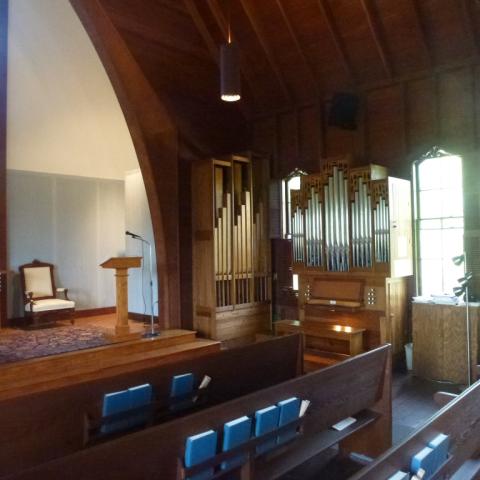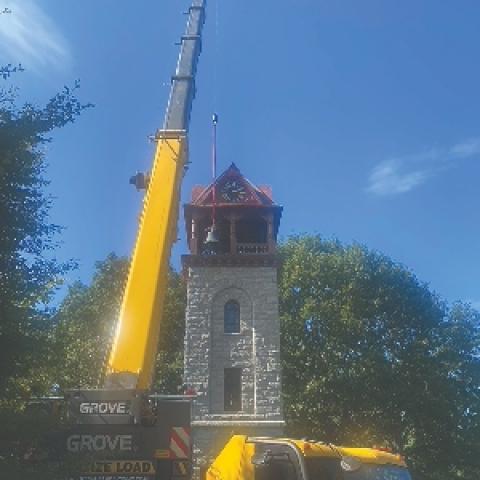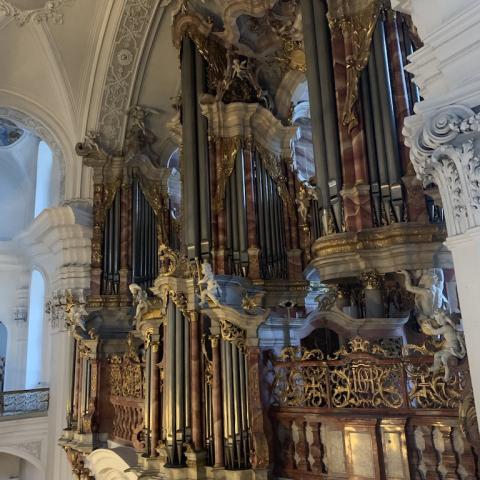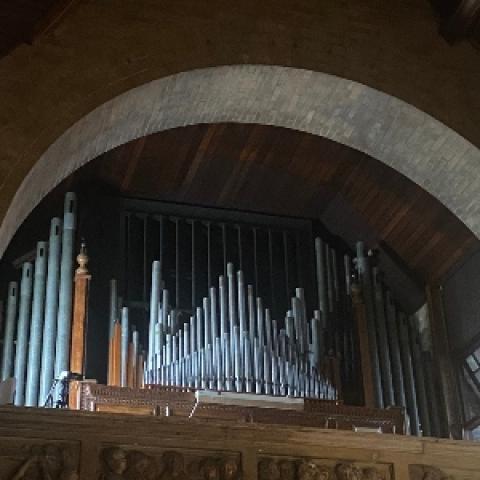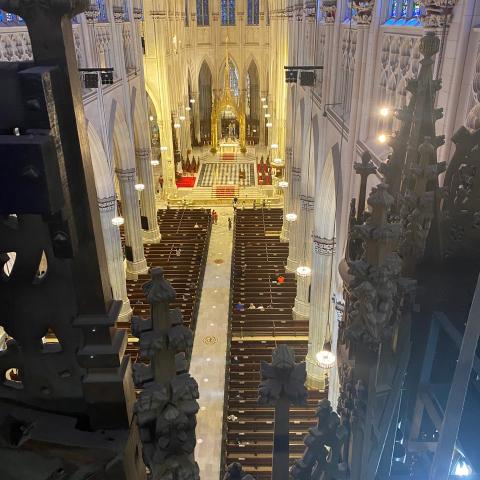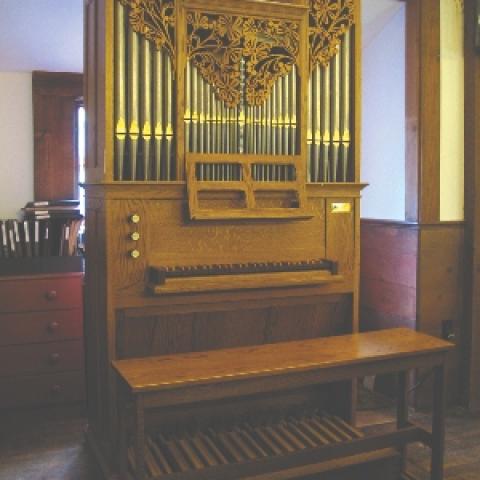
Spice is the variety of life.
Wendy and I love to cook. We send recipes from newspapers back and forth and thumb through cookbooks planning what the next fun will be. We have picked up the vernacular of Asian, Middle Eastern, and Caribbean dishes. We grill and smoke meat and vegetables outside at our place in Maine (running a smoker in a New York City apartment is frowned upon), and we even have a lamb-sized charcoal rotisserie that has produced several memorable holiday events.
Some years ago, my brother and his wife gave us an assortment of spice mixes from a local boutique, and I have been ordering stuff from them ever since. Something as simple as their Tellicherry peppercorns are a revelation. The name does not refer to a place of origin, but rather to the larger size of the peppercorns. Open the jar, take a whiff, and you know you are into something special. We have Caribbean seasoning with dried orange peel, chili peppers, and ginger that adds a dimension to grilled chicken. We have a Moroccan spice rub that is heavenly on grilled pork tenderloin with pilaf on the side, and a Merguez mix often found in lamb sausages that is marvelous on a butterflied leg of lamb.
We have an artisanal butcher near us in Maine (I often send him photos of my outdoor triumphs), three or four organic farms, and as we are on the Maine coast, there are lobster, oysters, clams, scallops, and all sorts of fish. We keep a small garden with basil, oregano, sage, and chives. I consulted for a private school in Thailand in 2010, where I learned a few magic hints about how to achieve authentic flavors, and my pad thai is a family favorite. Our daughter and son-in-law live in Bay Ridge in Brooklyn, home of a wonderful middle eastern Halal market, and as our son-in-law is Greek, we have discovered rich sources of Greek ingredients in Astoria, Queens.
As the day ends, an hour and a half in the kitchen is a time for reflection, creativity, special little tastes, and marvelous aromas. Add to that the smell of woodsmoke and a cocktail, and all is right with the world.
Variety is the spice of life.
Consider the clarinet. While clarinetists know the differences from one instrument to another, to the untrained eye one clarinet looks pretty much like the next. The same applies to violins, flutes, trumpets, and pianos. But compare a monumental organ with hundreds of ranks of pipes to a three-stop continuo organ, and even a skilled organist might shake his head. It is hard to imagine that the two can be the same instrument. I have had rich experiences with dozens, even hundreds of organs of all shapes and sizes. Let me tell you about some of the organs I have known.
Aeolian-Skinner Opus 1203 (1951)
The organ at The First Church of Christ, Scientist (also known as the Mother Church), in Boston, Massachusetts, is a mighty instrument with 241 ranks, 166 stops (that’s right, lots of compound stops), more than forty ranks of reeds, ten sets of celestes, and forty-two independent ranks in the Pedal division alone. I was organ curator there for around fifteen years in the 1980s and 1990s, and managing its care was the challenge of a lifetime. While many organs of this scale had more modest beginnings and were gradually increased in size, #1203 was built as one opus number all at once, and its original design is breathtaking. It is three stories tall and three “departments” wide, with the thirty-eight-rank Swell division (including a full-length 32′ Kontrafagott and 5-1⁄3′ Quinte Trompette) at the center. The Solo division that includes the Cor des Anges on twenty-five inches of wind speaks through a round grille high in the room to the left of the organ. While I was sitting next to a colleague listening to Catharine Crozier’s recital at an American Guild of Organists convention, my friend leaned over and whispered to me, “This organ is a gold mine at mezzo piano.” And it is loaded with real gold, too. There is an acre of gold leaf on the magnificent display of façade pipes.
I was thrilled to play “First Night” concerts there several years in a row with a brass quintet from the Boston Symphony Orchestra and audiences of more than 3,000. Thinking that I would be the big man at the helm of that huge organ, I learned a lesson about the power of the bass line from Chester Schmidt, tubist for the BSO, whose rhythmic drive meant I had a tiger by the tail.
Bedient Pipe Organ Company Opus 42 (1994)
After he retired from a long ministry in Winchester, Massachusetts, my father was interim rector of Saint Mary of the Harbor Episcopal Church in Provincetown, Massachusetts. It is a lovely little church right on the fabled beach, with a rectory next door, a swell place to spend time. The organ is about as far as you can get from the Mother Church, tracker action with three stops, 8′ Gedackt, 4′ Rohrflute, and 2′ Praestant. Oh, and there is a pedalboard with a coupler. It is barely six feet tall, and sitting on the bench, you can wrap your arms around the case. While Dad was serving there, I played an evensong recital for the congregation, a program of sweet little pieces by Handel, Bach, Krebs, and the Vivaldi/Bach A-minor concerto. I’m a big guy, and I felt as if I was riding a tricycle.
An elderly couple, members of the church and one of the first couples to “come out” in Provincetown, gathered the money to pay for the organ by collecting returnable cans and bottles. They rooted through restaurant dumpsters, combed the beaches, collected empties from their friends, and they raised more than $25,000—a nickle at a time. It is a parish tradition to have a potluck dinner on the Fourth of July ahead of the fireworks display over the water. Tom tried a piece of cake and went back for a second piece. Thinking no one was looking, he swooped back and walked off with the entire cake. Someone whispered to the woman who had brought the cake, and she replied, “I’m glad he liked it.”
I maintained that organ for about twenty years, visiting once a year whether it needed it or not. The drive to Provincetown covers all points of the compass. After crossing the bridge from the mainland, you drive east to Orleans, north to Truro, west into Provincetown, and south to the church. It is about 115 miles from Boston, a long way to go for three stops.
Roy Carlson (ca. 1968)
I was director of music at Centre Congregational Church in Lynnfield, Massachusetts, for almost twenty years where the Carlson organ had three manuals and thirty-six ranks. Every stop was useful, and several of them were beautiful; otherwise the organ was unremarkable. There were two open 16′ flues, Principal and Spitzflute, that spoke promptly and well, and two expressive divisions. I played this organ more than any other instrument I have known. The chapel was air-conditioned, so we worshipped there in the summer. We used the main sanctuary for forty Sundays each year, so I guess I played more than 750 services. Twenty weddings a year made the total nearly 1,500, plus recitals and more. I was comfortable at the organ, played all sorts of repertoire, and led the choir through all the usual masterworks.
There was a large, dedicated choir room under the chancel. It was a luxurious space, but a little musty as it was a basement room, so I bought a couple dehumidifiers to take care of the piano, the music library, and the people, but they did not seem to work. I had asked the custodian to maintain them, and it took a few weeks before I realized that he was filling the tanks.
For the 275th anniversary of the parish, our pastor, Mark Strickland, went for the gold and invited William Sloane Coffin to speak at the celebratory banquet. He accepted. The choir and I prepared a review of hymns that might have been sung in different eras of the church’s history. When we got to “Life’s Railway to Heaven,” the Reverend Coffin shouted, “I haven’t heard that one in years,” ran over to the choir, and joined in, every verse memorized long ago.
Flentrop Orgelbouw (1977)
Trinity Episcopal Cathedral in Cleveland, Ohio, is a lovely Gothic building on Euclid Avenue, just east of downtown. I was a student at Oberlin and working for John Leek when the Flentrop organ was delivered there. John was a first-generation Hollander and friends with the people at Flentrop, and we were hired to help with the installation. The organ arrived from Rotterdam to the Port of Cleveland on the container ship Calliope, and we carried the bulk of the organ up the stone steps into the cathedral. I was used to the three-manual Flentrop at Oberlin that was dedicated in November of my freshman year, and was deep into historic performance practices, so I noticed with interest when I carried a box of expression shutters into the cathedral.
A small organ loft with a spiral staircase had been prepared, and we set up scaffolding towers on each side so we could hoist the heavy parts. I was on top of the growing tower with Jan Radenführer, the church’s sexton, when it looked as though we were going to run into the slope of the ceiling. Jan gave a shove and moved the tower from the top, an experience that informed me that, while I was not afraid of heights, I sure was afraid of falling. In those days I was the young strong guy. I wore a leather holster as if I was carrying a flag in a parade and walked slowly up a ladder with each shiny façade pipe hanging from my belt, while others above me balanced and guided them. Leaving the cathedral at the end of the day, we turned back to look at the organ, and the façade was basking in blue and red light from the afternoon sun shining through the stained-glass windows.
Daniel Hathaway was organist of the cathedral, a friend from my teenage days, and together we played four or five duo-recitals, four hands on the Flentrop and with the smaller Flentrop that had been installed a couple years earlier. Beethoven and Rossini sounded great in Werckmeister. Michael Jupin, who had been associate rector to my father in Winchester, was dean of the cathedral. My first wedding was held at Trinity with Mike, my father, two of my uncles, and my godfather as vested priests. That was the first big organ installation I participated in, and it was a formative experience to work and socialize with the talented people from the Netherlands.
Johann Georg Fux (1736)
In September of 2019, I spent a long week in Germany visiting a colleague organbuilder, and I made a few side trips to see and hear iconic organs. The organ by Johann Fux in the Fürstenfeld Kloster in Fürstenfeldbruck is a knockout. The church is one of those Rococo masterpieces with side altars with spiraling columns, murals, and statues everywhere—an army of carved angels. The organ is in the second balcony, high enough that it looks small. One reaches the organ by climbing and climbing and climbing an ancient stairway at the front of the church and walking down the length of the building about fifteen feet higher than the floor of the organ—you approach the organ from above. That’s when you realize that while it has fewer than thirty stops, those are 32′ pipes in the façade. It is enormous. It is humbling to think of that beautiful casework, huge pipes, gorgeous keyboards, and complex mechanism being built with eighteenth-century technology and hoisted to that lofty place.
Christoph Hauser is organist of the Kloster. I attended a Sunday Mass and was delighted by his tuneful, humorous, even sassy improvisations. His affinity for the organ was obvious and infectious. I was to meet Christoph after Mass and assumed he would appear at the back of the room. Quite a bit of time passed before I spotted him, looking every bit the organist, standing down front. We climbed the ladder behind the organ and opened case panels, getting a good look at the beautifully made components. He showed me the newly restored bellows, and he played for me. The organ is lusty and colorful. There are gentle flute and string voices, the big choruses with tierces are ebullient and boisterous, and the reeds are authoritarian.
That an organ more than 280 years old could have such relevance to our modern ears is testament to the timelessness of a great instrument. I was in the building for barely three hours including the Mass, but that intimate time with the organ will always be with me. I am grateful to Christoph for his generosity in sharing it with me.
E. & G. G. Hook Opus 283 (1860)
Woburn, Massachusetts, adjoins Winchester where I grew up. It was home to three organs by E. & G. G. Hook: Opus 646 (1872) in Saint Charles Borromeo Catholic Church, Opus 553 (1870) in the First Unitarian Church, and Opus 283 in the First Congregational Church. Two are still there, but the Unitarian church closed in 1990, and Opus 553, beautifully restored, is now in the Heilig Kreuz-Passion Church in Berlin, Germany, where it is known as “Die Berliner Hook.” Organ builder George Bozeman was organist at the Congregational church when I was in high school, and he asked me to join him as assistant organist so I could cover for him when his work took him out of town.
Opus 283 is a large, three-manual organ with trumpets on the Swell and Great, lots of lovely color, a big Double Open Wood Diapason, and a walloping Possaune [sic] with wooden resonators. The case has elements of Moorish design with round towers with minarets, and the organ has a commanding position high in the front of the room. I played there with and for George for about two years and have been back to visit the organ many times since. This organ has a famous twin, Opus 288 (1860) in Saint John’s Catholic Church in Bangor, Maine, making a spectacular pair of pre-Civil War instruments.
The Congregational Church was about two-and-a-half miles from our house, and I often walked the distance. One afternoon I arrived at the church and realized I had forgotten my key. No problem, one of the big windows was unlocked, so I opened it and climbed through. The thing is, the police station was next door. I told the friendly officer that I was the organist and had forgotten my key, and he believed me.
As my senior year of high school was ending and commencement was approaching, I agreed to accompany a concert of the all-elementary chorus in a school near my house. I attended a couple rehearsals, and all was well. Friends suggested we go to the beach after church. Sure, sounds like fun. When I got home from the beach, I learned there had been a slew of telephone calls. I had missed the concert. To deepen the embarrassment, it was the organist of my home church where Dad was rector, whose daughter was in the chorus, who answered the call from the stage if anyone in the house could accompany the concert.
Oh remember not the sins and offenses of my youth, but according to Thy mercy, think Thou on me, O Lord.
Photo credit: John Bishop

